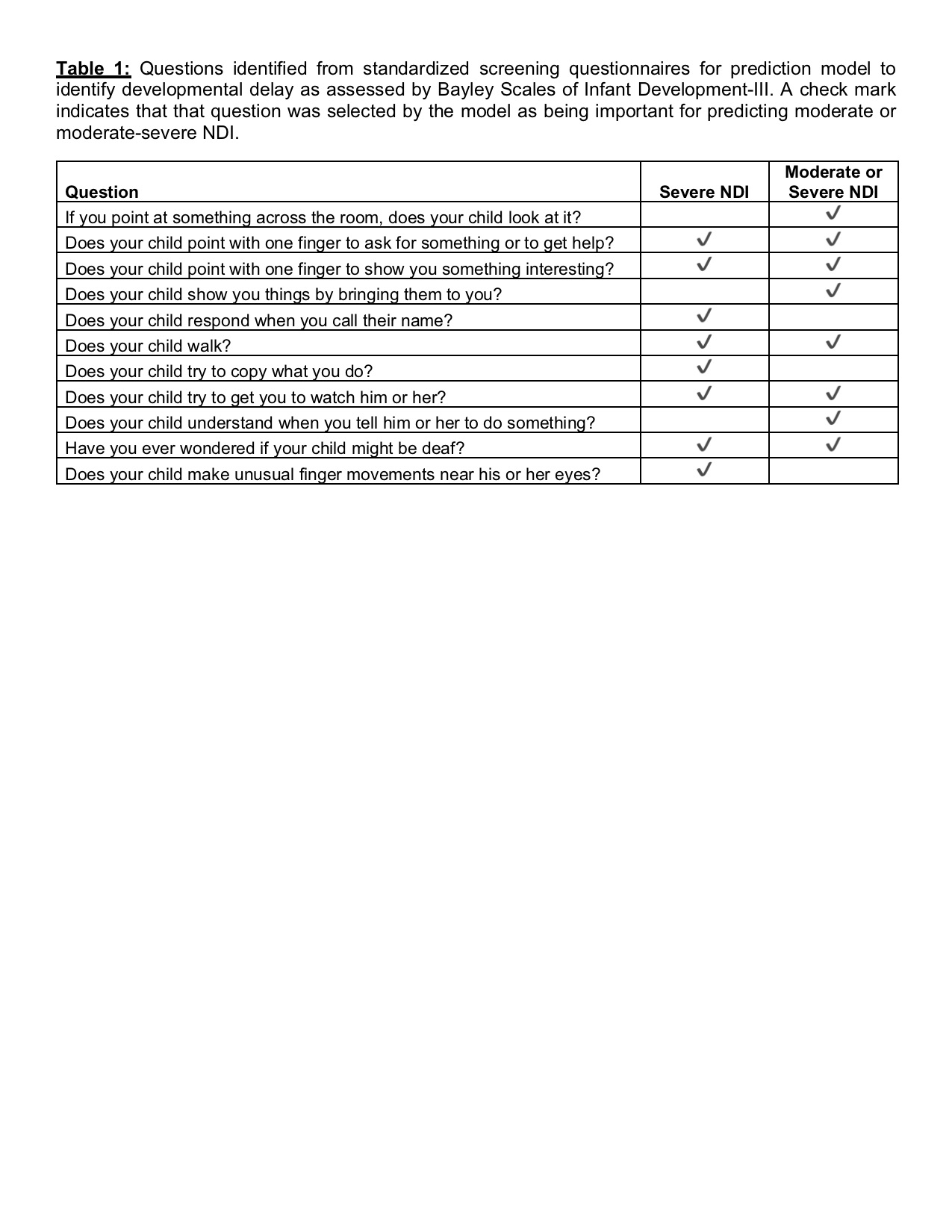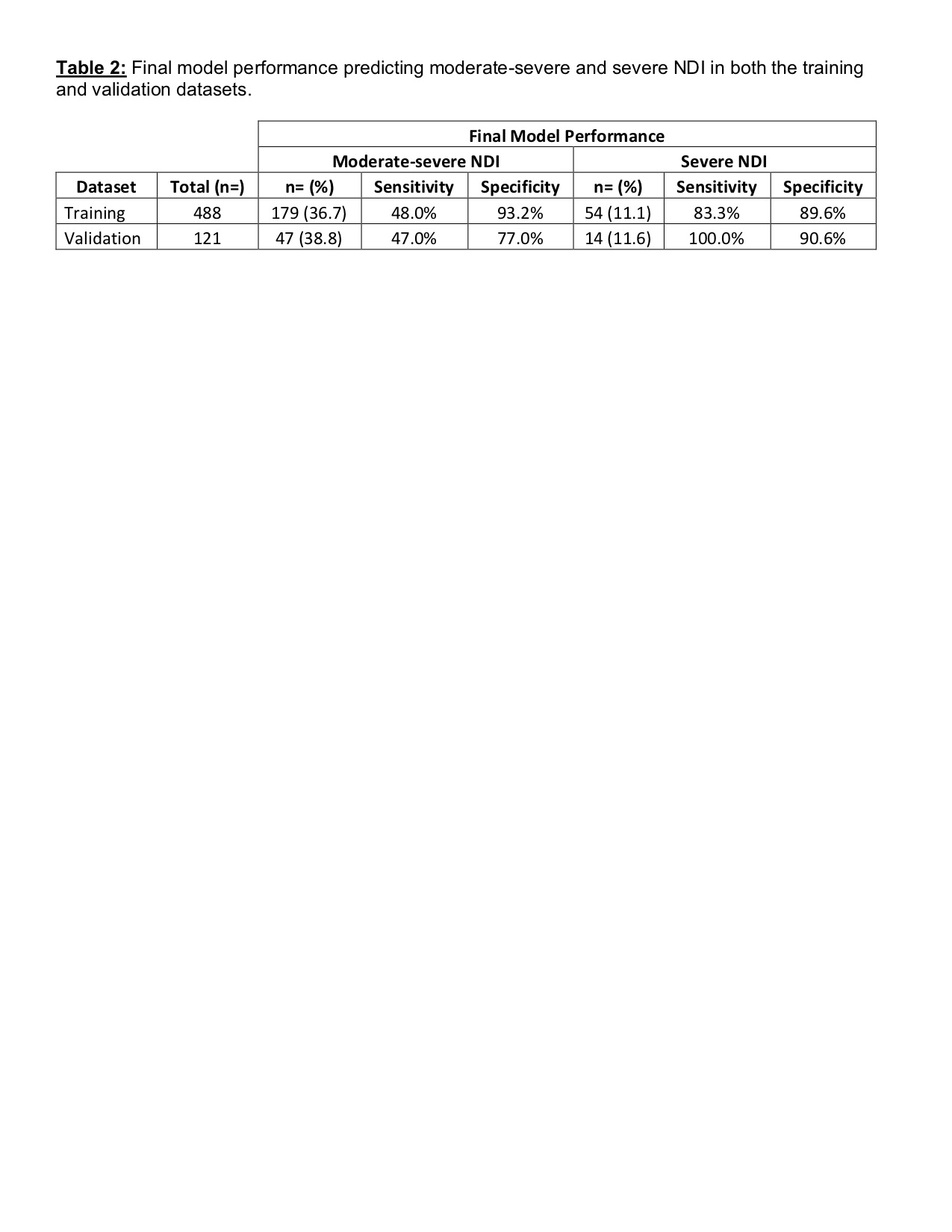Neonatal Follow-up
Category: Abstract Submission
Neonatal Follow-up I
446 - Identification of Preterm Infants at High Risk of Developmental Delay at 2 Years of Age Using a Parent Questionnaire
Friday, April 22, 2022
6:15 PM - 8:45 PM US MT
Poster Number: 446
Publication Number: 446.121
Publication Number: 446.121
Kendell German, University of Washington, Seattle, WA, United States; Tommy Wood, University of Washington School of Medicine, Seattle, WA, United States; Bryan A. Comstock, University of Washington, Seattle, WA, United States; Janessa Law, University of Washington School of Medicine, Seattle, WA, United States; Mihai Puia-Dumitrescu, University of Washington School of Medicine, Seattle, WA, United States; Krystle M. Perez, University of Washington School of Medicine, Snohomish, WA, United States; Gregory C. Valentine, University of Washington, Tacoma, WA, United States; Sarah E. Kolnik, University of Washington School of Medicine, Seattle, WA, United States; Dennis E. Mayock, University of Washington, LAKE FOREST PARK, WA, United States; Semsa Gogcu, Wake Forest Baptist Health - Brenner Children's Hospital, Winston Salem, NC, United States; Patrick Heagerty, University of Washington, Seattle, WA, United States; Robert Joseph, Boston University, Boston, MA, United States; Sandra E. Juul, University of Washington, Seattle, WA, United States

Thomas R. Wood, MD, PhD (he/him/his)
Assistant Professor
University of Washington School of Medicine
Seattle, Washington, United States
Presenting Author(s)
Background: Universal follow-up of infants born < 28 weeks’ gestation is recommended, however, in-person assessment for some families may be challenging, as the COVID-19 pandemic has highlighted. A reliable screening approach to identify children at highest risk of neurodevelopmental impairment (NDI) is needed.
Objective: To determine whether a remotely-administered parental survey of standardized developmental yes/no questions derived from the Modified Checklist for Autism, Revised (MCHAT-R) can predict NDI as assessed by the Bayley Scales of Infant Development, 3rd Edition (BSID-III) and standardized neurologic exam, all administered at 22-26 months corrected age. The MCHAT-R is a standardized screening questionnaire that assesses social-cognitive milestones, questions from this screener were evaluated as potential predictors of NDI.
Design/Methods: This is a post-hoc analysis of data from the Preterm Erythropoietin Neuroprotection Trial (PENUT), a multi-center, prospective randomized trial of infants born at 24 to 27-6/7 weeks’ gestation. Responses to questions derived from the MCHAT-R were correlated with BSID-III motor or cognitive score < 85 or any cerebral palsy (CP) (moderate NDI) and with BSID-III motor or cognitive scores < 70 or moderate-severe CP (severe NDI). Lasso regression was employed to select the MCHAT-R questions most predictive of moderate-severe or severe NDI, using 10-fold cross-validation to select the model with lowest binomial deviance. Data were randomly split 80:20 for model training and validation, respectively.
Results: A total of 609 infants had complete BSID-III, neuro exam and MCHAT-R results and were included. Of these, 25.9% (n=158) had moderate NDI and 11.2% (n=68) were classified as severe. 11 yes/no questions from the MCHAT-R were predictive of NDI (Table 1). Figure 1 shows Receiver Operator Characteritsic (ROC) curves for predicting NDI during model development, with final model performance in the training and test datasets shown in Table 2. In the validation dataset, moderate-severe NDI was predicted with 48.0% sensitivity and 93.2% specificity, and severe NDI was predicted with 100% sensitivity and 90.6% specificity.Conclusion(s): A subset of remotely-administered yes/no questions derived from the MCHAT-R predict formally-assessed NDI, particularly in infants with severe NDI. These questions could help identify infants at particularly high risk for NDI for whom resources should be prioritized to facilitate in-person assessment.
Questions identified from standardized screening questionnaires for prediction model to identify developmental delay as assessed by Bayley Scales of Infant Development-III. A check mark indicates that that question was selected by the model as being important for predicting moderate or moderate-severe NDI.
A check mark indicates that that question was selected by the model as being important for predicting moderate or moderate-severe NDI.
Final model performance predicting moderate-severe and severe NDI in both the training and validation datasets
Objective: To determine whether a remotely-administered parental survey of standardized developmental yes/no questions derived from the Modified Checklist for Autism, Revised (MCHAT-R) can predict NDI as assessed by the Bayley Scales of Infant Development, 3rd Edition (BSID-III) and standardized neurologic exam, all administered at 22-26 months corrected age. The MCHAT-R is a standardized screening questionnaire that assesses social-cognitive milestones, questions from this screener were evaluated as potential predictors of NDI.
Design/Methods: This is a post-hoc analysis of data from the Preterm Erythropoietin Neuroprotection Trial (PENUT), a multi-center, prospective randomized trial of infants born at 24 to 27-6/7 weeks’ gestation. Responses to questions derived from the MCHAT-R were correlated with BSID-III motor or cognitive score < 85 or any cerebral palsy (CP) (moderate NDI) and with BSID-III motor or cognitive scores < 70 or moderate-severe CP (severe NDI). Lasso regression was employed to select the MCHAT-R questions most predictive of moderate-severe or severe NDI, using 10-fold cross-validation to select the model with lowest binomial deviance. Data were randomly split 80:20 for model training and validation, respectively.
Results: A total of 609 infants had complete BSID-III, neuro exam and MCHAT-R results and were included. Of these, 25.9% (n=158) had moderate NDI and 11.2% (n=68) were classified as severe. 11 yes/no questions from the MCHAT-R were predictive of NDI (Table 1). Figure 1 shows Receiver Operator Characteritsic (ROC) curves for predicting NDI during model development, with final model performance in the training and test datasets shown in Table 2. In the validation dataset, moderate-severe NDI was predicted with 48.0% sensitivity and 93.2% specificity, and severe NDI was predicted with 100% sensitivity and 90.6% specificity.Conclusion(s): A subset of remotely-administered yes/no questions derived from the MCHAT-R predict formally-assessed NDI, particularly in infants with severe NDI. These questions could help identify infants at particularly high risk for NDI for whom resources should be prioritized to facilitate in-person assessment.
Questions identified from standardized screening questionnaires for prediction model to identify developmental delay as assessed by Bayley Scales of Infant Development-III.
 A check mark indicates that that question was selected by the model as being important for predicting moderate or moderate-severe NDI.
A check mark indicates that that question was selected by the model as being important for predicting moderate or moderate-severe NDI.Final model performance predicting moderate-severe and severe NDI in both the training and validation datasets

